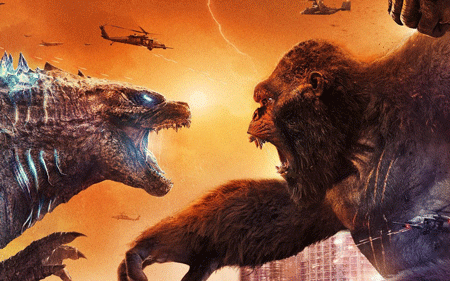Movies, Concerts, Sports, Theme Parks: which in-person events will survive?
As the U.S. pivots into post-COVID re-entry, a group of industries may spring back while others may dwindle towards insignificance. Center director Jeffrey Cole explores who is likely to win and lose.
By Jeffrey Cole
To almost everyone’s surprise, the Warner Bros. film Godzilla vs. Kong led the re-opening of America’s movies theaters after COVID, and earned close to $100 million in its first month at the domestic box office. International grosses are closing in on $500 million.
 While in any year these would be respectable numbers (even though it cost $160 million to make), when you factor in that some movie theaters are still closed and that most of those that are open are operating at limited capacity, a strong case can be made that movie theaters are on their way to returning to their historic place in American’s lives.
While in any year these would be respectable numbers (even though it cost $160 million to make), when you factor in that some movie theaters are still closed and that most of those that are open are operating at limited capacity, a strong case can be made that movie theaters are on their way to returning to their historic place in American’s lives.
Far more impressive is the fact that Godzilla vs. Kong is available at home for HBO Max subscribers with no additional fee. At the end of last year, Warner was sitting on over $1 billion invested in finished films and afraid there would be no place to put them for over a year, or possibly ever. It also wanted to give a boost to the lackluster launch of HBO Max. It then made the controversial call to put all their 2021 films (Wonder Woman 1984, Godzilla, The Matrix 4, and more) onto its new streaming service.
As vaccines made fans more comfortable, Warner still hoped to release films in theaters, but even if that never happened, HBO Max would be sure to attract millions of new subscribers.
“Day and Date” is only one experiment
The Warner Bros. experiment with HBO Max running films “Day and Date” (in theaters and streaming at the same time) is but one of many throughout the entertainment industry (and beyond) to see how behaviors and spending may be radically altered as we all emerge from COVID.
Disney, by releasing some films only in theaters, others for no additional fee on Disney+, and some with an additional fee (right now about $30) on top of a Disney+ subscription, wants to get this experiment right. Is the theater still critical to consumer awareness, building franchises, and (if they matter anymore) Academy Awards? Will only certain films (Godzilla is a spectacle looking best on an enormous screen) bring people back to $16 admissions and $12 for food (per person)?
These experiments are not limited to the relationship between movie theaters and streaming.
Only now are major sporting events available to in-person audiences. Has the audience gotten comfortable at home and out of the habit of paying $100 or much more to be in a stadium? Will concerns about COVID and other diseases ever bring 100,000 to a crowded Super Bowl or 50,000 to the World Series? Is our desire to watch our favorite sports satisfied on a big screen at home?
Concert promoters also worry whether they will ever again see thousands packed into very crowded spaces for two to three hours.
At the Center, we conducted an unscientific poll of those who bought tickets to Godzilla in the theater. We wanted to know whether they went to the theater to see that particular movie or just wanted to go to the movies and settled on Godzilla.
The response was about 90% the latter.
In other words, we want to get out of the house and need a place to go. Any place that is open will do.
Our COVID Reset Project (which is scientific) shows we have had enough. We want to go back to school, to the movies, to sporting events, to theme parks, and on airplanes—anywhere but the four walls of our homes that we see even when our eyes are closed.
It makes sense that millions went to Godzilla even though it was available to HBO Max subscribers. Some would have gone to see a test pattern in the theater (no disrespect to giant monsters)!
Who will win and who will lose?
In the burst of euphoria, feeling safe with vaccinations in our arms, and the hope that COVID is receding (at least in the U.S.), it is no surprise we are rushing to theaters, arenas, parks (theme and other) to reclaim our lives. The event itself is of secondary importance to the excitement of being there (or anywhere) again.
For theater owners, sports teams, and concert promoters, this raises a disturbing prospect: after going to a few movies, games, or concerts, will we get it out of our systems and recalibrate our behavior to at-home alternatives that are much more convenient and less expensive? Or will the pandemic just be a lost year, and all will soon be as it was?
What will 2021’s experiments show about business models? Can the movies, sports, concerts, and theme parks flourish without significance in-person attendance. Or, without it, will they shrink in size and importance?
There is no movie theater or theme park business without an audience making the time and effort to get there and spend money on the experience. With movies, there is an at-home alterative that many may find satisfactory or even superior. However, theme parks need people walking through the gate or the business collapses. Unlike movies, there is no alternative to showing up in person.
Concerts and stage plays are almost as dependent on live audiences as theme parks and theaters, but it is at least possible to watch them via streaming (with or without an additional fee).
Sports is in the best position coming out of COVID. Thousands in the stadium generates revenue as well as excitement and team loyalty. That revenue, however, is only a small supplement to television and streaming rights. With trillion-dollar bidders such Amazon, Google, and Facebook (and maybe Microsoft) entering the negotiations and driving up fees, in-person revenue will only shrink in financial importance to sports owners.
In our soon to be released COVID Reset Project, we devote one of seven sectors to entertainment. A significant area of focus is why fans may or may not return to movie theaters, ball parks, concerts, and theme parks.
The trends do not bode well for movie theaters
The opportunity to build a memory by being somewhere in person is more than twice as important to fans of concerts and theme parks than movie theaters. In creating high gravity products that pull fans into in-person experiences, movie theaters fare worse than all other forms of in-person entertainment.
In the burst of euphoria, feeling safe with vaccinations in our arms, and the hope that COVID is receding (at least in the U.S.), it is no surprise we are rushing to theaters, arenas, parks (theme and other) to reclaim our lives. The event itself is of secondary importance to the excitement of being there (or anywhere) again. For theater owners, sports teams, and concert promoters, this raises a disturbing prospect: after going to a few movies, games, or concerts, will we get it out of our systems and recalibrate our behavior to at-home alternatives that are much more convenient and less expensive? Or will the pandemic just be a lost year, and all will soon be as it was?
The other experiences, unlike movies in the theater, are live, which creates the possibility of a once-in-a-lifetime moment. The at home alternatives are closer to the in-person experience with movies than with any of the other activities.
For movie theaters, whether fans will return is an existential question. It isn’t so much that all theaters will close and disappear, as whether the business will shrink (as it has for 70 years) into irrelevance. Pacific Theaters and ArcLight in Southern California have already closed their doors forever. And these were theaters built to create a unique movie experience far more difficult to replicate at home.
For concerts and theme parks, the future of people coming through the gate is also an existential issue. Digital downloading and then streaming forever changed the music business. Before 2000, successful acts could make millions of dollars and command fan attention through record sales. Some albums (Thriller, The Eagles Greatest Hits) sold over 30 million copies. Touring helped but was not mandatory. After two years, The Beatles did almost no touring, and it hurt neither their sales nor their popularity.
Then, when downloading disrupted music sales, touring became the lifeline to a group’s financial success. Like theme parks, concerts offer an experience not available anywhere else.
For sports, the question of whether fans will return as they did before is not existential. Many sports fans say they will come back because they want to show support for their team, wearing clothing and colors that demonstrate that support. But our work suggests that—even when people feel safe—only critically important games are likely to fill a stadium to over 100,000 people.
These are the experiments of 2021-22. With our new work, we are well positioned to quickly understand which events will return to pre-pandemic norms, which will survive in a diminished way, and which may never return.
It’s time to place our bets. One guarantee: 2022 will look very different.
____________

Jeffrey Cole is the founder and director of The Center for the Digital Future at USC Annenberg.
See all columns from the center.
May 5, 2021

